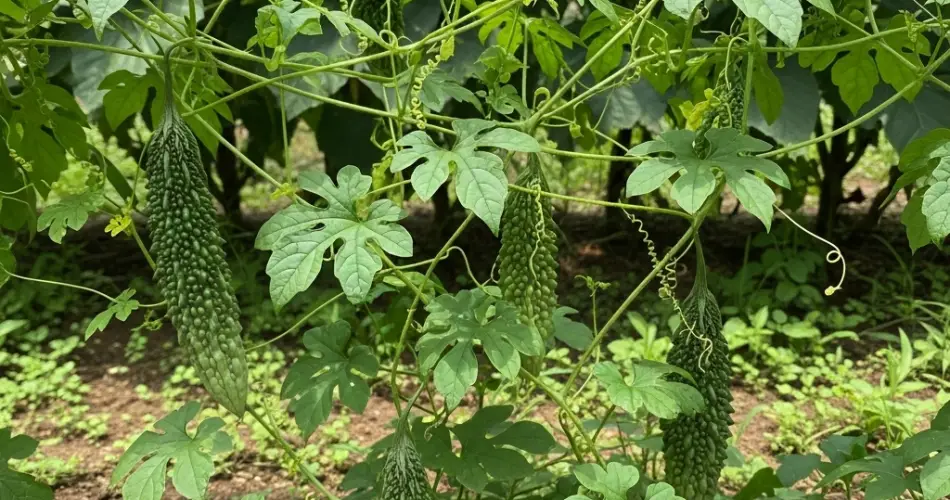Bitter melon, also known as bitter gourd or Momordica charantia, is a tropical vine that produces distinctively shaped fruits with a sharp, bitter taste. Though its flavor may not appeal to everyone immediately, bitter melon is a cherished ingredient in many Asian, African, and Caribbean cuisines. Beyond its culinary value, it’s also known for its health benefits, making it a worthwhile addition to your garden and diet.
Why Grow Bitter Melon?
Bitter melon is not only a flavorful addition to meals but also a nutritional powerhouse. It is rich in vitamins A and C, iron, potassium, and fiber. It’s traditionally used in many cultures to support digestion, blood sugar regulation, and overall wellness.
Growing bitter melon at home ensures access to fresh, chemical-free produce. The plant thrives in warm, humid climates and grows vigorously on trellises or fences, making it suitable for gardens with vertical space.
Getting Started: Choosing Seeds
Bitter melon comes in several varieties, generally categorized into two types:
-
Chinese bitter melon: Pale green with a smooth, warty surface and typically longer and narrower.
-
Indian bitter melon: Dark green, shorter, and more spiky in appearance.
Both offer similar benefits and can be used interchangeably in recipes, though the bitterness level may vary slightly. Choose a variety that suits your climate and culinary preferences. Seed packets are widely available from local garden centers or online sources.
Best Growing Conditions
Bitter melon thrives in warm weather and grows best in temperatures between 75°F and 85°F (24°C to 29°C). It needs full sun and well-draining soil that is rich in organic matter. A slightly acidic to neutral pH (6.0 to 7.0) is ideal.
This plant is sensitive to frost and should be planted outdoors only after the risk of cold weather has passed. In cooler climates, start seeds indoors 3 to 4 weeks before the last expected frost and transplant seedlings once temperatures remain consistently warm.
Planting and Supporting Growth
Soak seeds in warm water for 24 hours before planting to encourage germination. Plant them about ½ inch deep in seed-starting mix or directly in the garden if temperatures permit.
Once seedlings have developed two to three true leaves, space them about 12 to 18 inches apart. Bitter melon is a vigorous climber, so provide a strong trellis or vertical support early on. This keeps the vines healthy and improves air circulation, which helps prevent disease and makes harvesting easier.
Watering and Feeding
Keep the soil consistently moist but not waterlogged. Bitter melon needs regular watering, especially during dry spells, but be cautious not to overwater. Mulch around the base of the plants to retain moisture and suppress weeds.
Fertilize every few weeks with a balanced organic fertilizer or compost tea. Avoid excess nitrogen, which can encourage leafy growth at the expense of fruit production.
Pollination and Fruit Development
Bitter melon produces both male and female flowers, and pollination is required for fruit set. Bees and other insects usually handle this, but if fruit production is low, hand-pollination can help. Use a small brush or cotton swab to transfer pollen from male to female flowers.
The fruits begin to develop shortly after pollination and grow rapidly. Harvest when they are still green and firm—overripe fruits become too bitter and develop a yellow or orange hue. Regular harvesting encourages more fruit production throughout the season.
Common Pests and Problems
Watch out for common pests like aphids, fruit flies, and spider mites. Use organic pest control methods such as neem oil or insecticidal soap to manage infestations. Also, regularly inspect the undersides of leaves where pests often hide.
Fungal issues like powdery mildew or downy mildew can occur, especially in humid conditions. Ensure good air circulation, avoid overhead watering, and apply organic fungicides if necessary.
Harvesting and Storing
Bitter melons are ready for harvest about 12 to 16 weeks after planting. Pick the fruits when they are still green, slightly glossy, and measure 4 to 6 inches in length. Use garden shears or scissors to cut the fruit from the vine, leaving a bit of stem attached to prolong freshness.
Store harvested bitter melons in the refrigerator, where they will keep for up to a week. They can also be sliced and frozen for future use.
Cooking with Bitter Melon
To temper the bitterness, slice the melon and soak it in salted water for 15 to 20 minutes before cooking. Some people also blanch the slices briefly before adding them to dishes.
Bitter melon can be stir-fried with eggs, stuffed with ground meat, simmered in soups, or used in curries. It pairs well with bold flavors like garlic, chili, onion, and soy sauce.
Embracing the bold, bitter flavor of this unique gourd opens the door to new culinary experiences and health benefits. With the right conditions and a bit of patience, bitter melon can become a valuable and productive part of your home garden.



